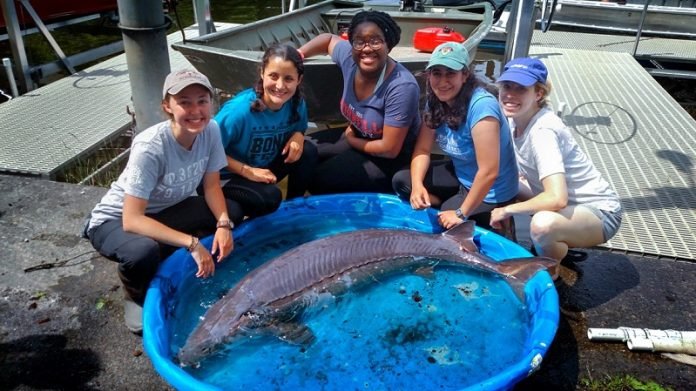
That fish was THIS big.
Really, it was.
Researchers from the Cornell Biological Field Station at Shackelton Point on Oneida Lake, in Bridgeport, New York, caught, tagged and released a 139-pound lake sturgeon – a threatened species – possibly the largest fish ever caught on that lake.
In May and June during an annual lake wide survey, the researchers capture sturgeon for a census of living creatures living in the lake.
This sturgeon, caught June 19, measured 72.5 inches and was estimated to be 20 years old.
Lake sturgeon once thrived in Oneida and Cayuga lakes, but due to tributary dam construction, habitat degradation and overfishing as anglers harvested their eggs for caviar, the sturgeon population dove to near-zero.
New York listed it as a threatened species in 1983.
About 25 years ago, the New York State Department of Environmental Conservation, in cooperation with the United States Fish and Wildlife Service, began stocking a large number of lake sturgeon fingerlings in Oneida Lake as part of a statewide sturgeon restoration program, according to Tom Brooking, research support specialist in Cornell’s Department of Natural Resources.
Sturgeon fingerlings are raised at the Oneida Fish Cultural Station in Constantia, New York, and at the Genoa National Fish Hatchery in Wisconsin, for transport back to New York waters.
“The recent sturgeon captures are almost certainly a direct result of the highly successful stocking program,” Brooking said.
Last year, the researchers at Oneida Lake caught a 104-pounder.
Brooking said historical newspaper accounts reveal only about a dozen large sturgeon taken from Oneida Lake, mostly from 1856-1920, with weights up to 105 pounds – making the most recent lake sturgeon catch the largest fish ever documented in Oneida Lake.
Farther west, sturgeon are making a comeback on Cayuga Lake, according to Lars Rudstam, professor of natural resources and director of the Cornell Biological Field Station.
Sturgeon are starting to spawn in Fall Creek, a tributary on Cayuga Lake’s south end, he said.
“This large fish is an indication that Oneida Lake is healthy,” said Randy Jackson, senior research associate and associate director of the field station.
“When you can take a species that has been struggling statewide because of things humans have done and maintain them in places like Oneida and Cayuga lakes – and it looks like they’re doing well – it is a sign that we’re doing a good job not letting our systems degrade.”
Written by Blaine Friedlander.



